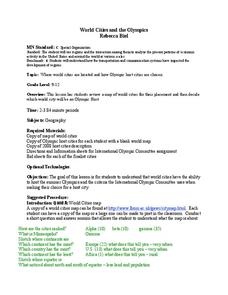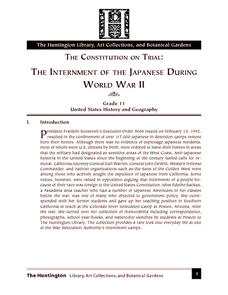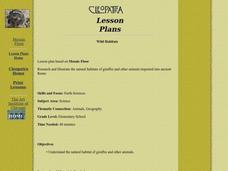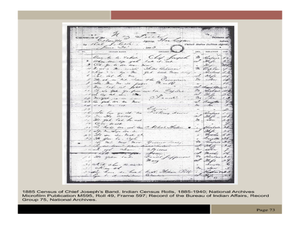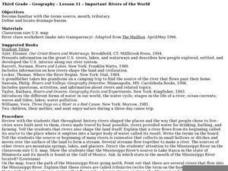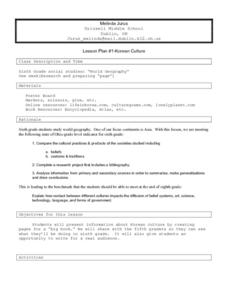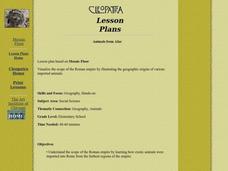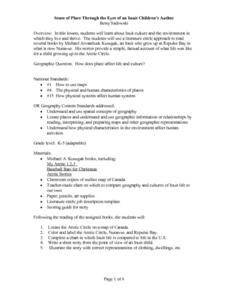Curated OER
World Cities and the Olympics
Students examine the various cities in which Olympics have been held. Using a map, they describe the reasons why those cities were chosen and choose their own city for the Olympics and state the reasons why. They examine information...
Curated OER
Family History
Eighth graders examine immigration patterns. In this family history lesson, 8th graders investigate their own family histories and then compare and contrast immigration patterns of their class to national immigration patterns between...
Curated OER
The Constitution on Trial: The Internment of the Japanese During World War II
Eleventh graders analyze primary source documents during the Second World War. Students recall statements of Japanese-Americans who were placed into internment camps during the war.
Curated OER
Wild Habitats
Students research and Illustrate the natural habitats of giraffes and other animals imported into ancient Rome. They draw a map of Europe, North Africa, and West Asia and draw the animals that come from each region in their proper places.
Curated OER
Lewis and Clark: Meeting the Indians of the Northwest
Eighth graders examine the relationships forged with Native Americans by Lewis and Clark. In this Westward Expansion lesson, 8th graders research digital and print sources to study details regarding the Native American tribes that Lewis...
Curated OER
Chief Joseph and the Nez Perce
Eleventh graders explore the life of Chief Joseph and Nez Perce. In this US History lesson, 11th graders analyze paintings and photos detailing the flight of Nez Perce. Students create a narrative newspaper article based on their...
Curated OER
Can You Control Floods
Students assume the role of an engineer or planner. As an engineer or planner they must come up with ideas that can be put into place to control floods. They produce a working model of flood control.
Curated OER
Greetings!
Students investigate the ways in which people greet each other. They read a book about greetings, participate in a role-playing game about greetings, interview family members about greeting styles and report their observations to the class.
Curated OER
Populations in the Path of Natural Hazards
Learners read "Geographical Mobility: 1995-2000." They examine the maps in the handouts and compare them with maps from an atlas. In the second part of this instructional activity, students read "In Harm's Way." They receive three more...
Curated OER
Island Breezes: Exploring Hula Dance
Students explore Hawaii and the art of hula dance. In this art lesson, students research the art of hula dance and Hawaii. Students create their own unique hula dance.
Curated OER
Africa Falls Prey to H.I.V.
Students use maps, statistics, and written texts to recognize the H.I.V. explosion in Africa.
Curated OER
Physical Location; How a Border Town Might Develop
Students speculate how a location can develop into a large town. They investigate the physical resources and how populations can grow. There are guiding questions to help students through the research and class discussion. Students make...
Curated OER
Important Rivers of the World
Third graders become familiar with names of the different parts of a river, define and locate drainage basins, locate six of the continents and explore the major rivers on each one, conduct research on a river of their choice.
Curated OER
To War or Not To War!
Ninth graders examine the various types of propaganda used during World War II. In groups, they make notes on each example and determine why they believe the opinion of the United States involvement in the war changed. They share their...
Curated OER
Science: Trouble in the Troposphere
Students research a NASA Website and record information about an assigned city's tropospheric ozone residual monthly climate. In groups, they graph the information for the past year. They form new groups and compare their city's...
Curated OER
Japaneses Internment: Lesson 1 of 4: Chronological Events Leading to Internment
Students examine facts about history of the Asians experience in America and identify patterns of Asian immigration in the United States. Students develop reasons specific Asian ethnic groups migrated to the United States and predict...
Curated OER
What is Migration
Students conduct individual research and participate in discussion be able to identify difference between forced and voluntary migration. They identify if push and pull factors are caused by political, social, economic, or environmental...
Curated OER
The European Union
Ninth graders construct a timeline depicting the development of the European Union and label and color countries on a map belonging to it. They write essays about how the Union affects the United States.
Curated OER
Introductions
Students participate in the introductions at the beginning of the semester. As a class, they brainstorm questions that can be asked to gain more information about their classmates. Working in pairs, the students interview each other and...
Curated OER
Korean Culture
Sixth graders complete a research project for the sixth grade Big Book that is to be shared with the 5th graders. Students should take their time because the project represents them and the whole class.
Curated OER
Animals from Afar
Pupils visualize the scope of the Roman empire by illustrating the geographic origins of various imported animals. They study how exotic animals were imported into Rome from the farthest regions of the empire.
Curated OER
Sense of Place Through the Eyes of an Inuit Children's Author
Students read books by Michael Arvaaluck Kusugak to explore life in the Artic Circle. After reading the books, students compare and contrast life in the Artic Circle to life in the United States. They write and illustrate a story about...
Curated OER
We The People
Students engage in this introductory unit of history which is ideal for the first few weeks of instruction. The unit is meant to prepare students for the nation wide contest associated with History Day.
Curated OER
The English Settle America
Sixth graders compare immigration today with that of the colonial period. They locate colonies on a map and describe reasons their families immigrated to the United States.


